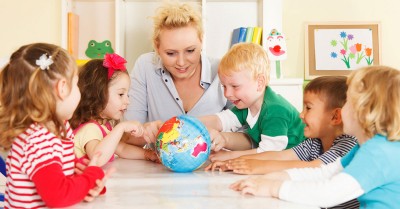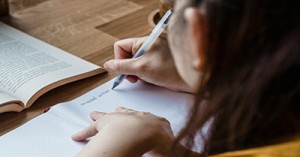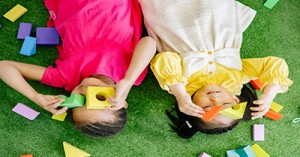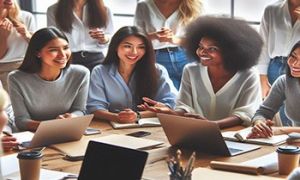The following lists the sub-outcomes, examples of evidence when children achieve each sub-outcome and how educators can promote and help children to achieve EYLF Outcome 4 - Children Are Confident And Involved Learners V2.0.
When children's stores of knowledge, as well as their family's and community's funds of knowledge (experiences and understandings), are acknowledged and included in the early childhood curriculum, children are more likely to be self-assured and engaged learners. Children can then expand on their prior knowledge and draw connections to help them make sense of novel events.
Through active, hands-on research, children grow in their awareness of who they are and the world around them. All children are encouraged to participate in learning in a supportive environment that supports active learning. This participation can be seen in the children's intense concentration and total focus on the subjects that pique their interests. Children approach learning with their whole selves. They each have their own preferred learning methods, perspectives on the world, and ways of learning.
Knowing each child as an individual is essential for educators to create a setting and experiences that will maximise each child's learning and thinking.
Learning Outcome 4 - Children Are Confident And Involved Learners V2.0
Children develop a growth mindset and learning dispositions such as curiosity, cooperation, confidence, creativity, commitment, enthusiasm, persistence, imagination and reflexivity
This is evident when children, for example:
- express wonder and interest in their environments
- are curious and enthusiastic participants in their learning
- share their ideas with others and ask questions of adults
- use play to investigate, experiment, test hypotheses, imagine and explore ideas
- follow and extend their own interests with enthusiasm, energy and concentration
- initiate and contribute to play experiences emerging from their own ideas
- participate in a variety of rich and meaningful inquiry-based experiences
- explore diverse ways of knowing, being and doing in their learning
- persevere and experience the satisfaction of achievement
- persist even when they find a task difficult
- use positive self-talk when trying to overcome a problem or setback
- revisit previous learning experiences and plan new challenges
- engage in creative experiences such as art, dance and drama
- positively respond to and incorporate the ideas of others to construct new learning
- use their senses to play, explore and try new things
- talk about what is happening in their brain when they are learning new things.
Educators promote this learning for all children when they, for example:
- recognise and value children’s involvement in learning
- provide learning environments that are flexible and open-ended
- respond to children’s displays of learning dispositions by commenting on them and providing encouragement and additional ideas
- model strategies such as positive self-talk to assist children to manage struggles and cope with challenges or setbacks
- provide feedback to children focused on effort and process over outcome or product
- encourage children to engage in both individual and collaborative explorative learning processes
- listen carefully to children’s ideas and discuss with them how these ideas might be developed
- include a growth mindset model in their everyday activities
- find out how to talk to children about how their brains work and how it grows as they learn
- provide opportunities for children to revisit their ideas and extend their thinking
- model inquiry processes, including wonder, curiosity and imagination, try new ideas and take on challenges
- reflect with children on what and how they have learned
- build on the funds of knowledge, languages and understandings that children bring to their early childhood setting
- explore the diversity of cultures and social identities
- critically reflect on personal responses to the cultural diversity that includes Aboriginal and Torres Strait Islander culture
- create responsive learning environments that promote shared sustained thinking.
Children develop a range of learning and thinking skills and processes such as problem-solving, inquiry, experimentation, hypothesising, researching and investigating
This is evident when children, for example:
- use trial and error to explore different possibilities through ‘cause and effect’
- initiate investigative play to solve self-generated problems and discoveries
- apply a wide variety of thinking strategies to engage with situations and solve problems, and adapt these strategies to new situations
- create and use representation to organise, record and communicate mathematical ideas and concepts
- make predictions and generalisations about their daily activities, aspects of the natural world and environments, using patterns they generate or identify and communicate these using
- mathematical language and symbols
- explore their environment through asking questions, experimenting, investigating and using digital technologies
- connect with their local Aboriginal and Torres Strait Islander community (e.g. Elders, role models) to engage with stories about place-based history and culture
- manipulate objects and experiment with cause and effect, trial and error, and motion
- contribute to mathematical discussions and arguments
- use reflective thinking to consider why things happen and what can be learned from these experiences
- develop and test theories to solve problems
- use a range of strategies and digital tools to organise and represent mathematical and scientific thinking
- use a range of media to express their ideas through the arts, e.g. clay, drawing, paint, digital technologies
- engage with culturally relevant objects to test ideas and represent mathematical concepts.
Educators promote this learning for all children when they, for example:
- plan learning environments that are flexible, with appropriate levels of challenge where children are encouraged to explore, experiment and take appropriate risks in their learning
- recognise mathematical understandings that children bring to learning and build on these in ways that are relevant to each child
- provide resources for very young children to explore the properties of materials through manipulating, rotating, collecting, transporting and positioning
- provide children with resources that offer challenge, intrigue and surprise, support their investigations and share their enjoyment
- provide experiences that encourage children to investigate and solve problems
- use language to describe (verbalise) back to children their investigations and learning experiences
- talk to children about how the brain works
- encourage children to use language to describe and explain their ideas
- provide opportunities for involvement in experiences that support the investigation of ideas, complex concepts and thinking, reasoning and hypothesising
- help and encourage children to express or make visible their ideas and theories to others
- model mathematical and scientific language, e.g. count out loud and point out patterns
- join in children’s play and model reasoning, predicting and reflecting processes and language
- intentionally scaffold children’s understandings, including a description of strategies for approaching problems
- listen carefully to children’s attempts to hypothesise and expand on their thinking through conversation and questioning
- provide opportunities for Aboriginal and Torres Strait Islander educators to provide feedback and reflect on everyday practices within their setting
- ensure documentation of learning is visible to encourage the revisiting of ideas and concepts
- support children’s extended investigations with flexible schedules to allow for multiple solutions and ways of thinking to be explored
- model the use of digital technologies and media to assist children to investigate and document their findings
- use cooking experiences, as well as sand and water play, to support mathematical and scientific skills such as observation, reasoning and measurement.
Children transfer and adapt what they have learned from one context to another
This is evident when children, for example:
- practice and imagine relationships and experiences in their daily lives through pretend or symbolic play
- engage with others to co-construct learning
- develop an ability to mirror, repeat and practice the actions of others, either immediately or later
- make connections between experiences, concepts and processes
- use the processes of play, reflection and investigation to solve problems
- apply generalisations from one situation to another
- try out strategies that were effective to solve problems in one situation in a new context
- transfer knowledge from one setting to another
- use strategies to reflect on and assess their learning and thinking.
Educators promote this learning for all children when they, for example:
- provide play opportunities and realistic materials that reflect children’s daily lives
- value signs of children applying their learning in new ways and talk about this with them in ways that grow their understanding
- support children to construct multiple solutions to problems and use different ways of thinking
- draw children’s attention to patterns and relationships in the environment and in their learning
- plan for time and space where children can reflect on their learning and see similarities and connections between existing and new learning
- share and transfer knowledge about children’s learning from one setting to another, by exchanging information with families and with professionals in other settings
- scaffold children’s understanding of how skills and ideas can be transferred to other activities through conversation and questions
- provide opportunities for all educators to participate in acknowledging the Country and how this can be used in different settings
- encourage children to discuss their ideas and understanding
- encourage and enable children to reflect on and assess their learning, including progress and next steps towards their learning goals
- understand that competence is not tied to any particular language, dialect or culture.
Children resource their own learning through connecting with people, places, technologies and natural and processed materials
This is evident when children, for example:
- engage in learning relationships with a wide diversity of people
- use their senses and body movements to explore natural and built materials and environments
- experience the benefits and pleasures of shared learning explorations, investigations and imaginary play scenarios
- explore the purpose and function of a range of tools, media, sounds and graphics
- manipulate natural and manufactured materials and resources to investigate, take apart, assemble, invent and construct
- experiment with different technologies
- use digital technologies and media to investigate and problem solve
- explore ideas and theories using imagination, creativity and play
- use feedback from themselves and others to revise and build on an idea
- engage in meaningful conversations about natural and processed materials
- create and construct artwork in a sustainable way using natural and manufactured materials and tools, drawing on Aboriginal and Torres Strait Islander stories, history, culture, customs and celebrations
- retell or create simple stories using materials or drama to represent ideas
- express and respond to ideas and feelings using a range of creative media including photography and digital technologies
- explore 2D and 3D forms of expression to develop an understanding of different art forms and elements
Educators promote this learning for all children when they, for example:
- provide opportunities and support for children to engage in meaningful relationships that provide positive learning opportunities
- provide sensory and exploratory experiences with a wide variety of open-ended natural and processed materials
- provide experiences that involve children in the broader community and environment beyond the early childhood setting
- think carefully about how children are grouped for play, considering possibilities for peer scaffolding
- select and introduce appropriate tools, technologies and media and provide the skills, knowledge and techniques to enhance children’s learning
- provide opportunities for children to both construct and take apart materials as a strategy for learning
- develop their skills and knowledge with digital technologies and media in their curriculum to use them confidently with children
- provide resources that encourage children to represent their thinking
- create opportunities to discuss with colleagues the diverse ways of embedding Aboriginal and Torres Strait Islander perspectives into everyday practice
thoughtfully introduce questions and adopt active listening approaches to prompt problem-solving and creative solutions
Further Reading
EYLF Learning Outcomes Version 2.0 - The following articles provide a list of the 5 EYLF Learning Outcomes and their sub-outcomes (Version 2.0).
EYLF Outcome 1 - Child Have A Strong Sense Of Identity V2.0 - The following lists the sub outcomes, examples of evidence when children can achieve each sub outcome and how educators can promote and help children to achieve EYLF Learning Outcome 1: Children Have A Strong Sense Of Identity V2.0.
EYLF Outcome 2 - Children Are Connected With And Contribute To Their World V2.0 - The following lists the sub-outcomes, examples of evidence when children achieve each sub-outcome and how educators can promote and help children to achieve EYLF Outcome 2 - Children Are Connected With And Contribute To Their World V2.0.
EYLF Outcome 3 - Children Have A Strong Sense Of Wellbeing V2.0 - The following lists the sub-outcomes, examples of evidence when children achieve each sub-outcome and how educators can promote and help children to achieve EYLF Outcome 3 - Children Have A Strong Sense Of Wellbeing V2.0.
EYLF Outcome 5 - Children Are Effective Communicators V2.0 - The following lists the sub-outcomes, examples of evidence when children achieve each sub-outcome and how educators can promote and help children to achieve EYLF Outcome 5 - Children Are Effective Communicators V2.0.







 Here is the list of the EYLF Learning Outcomes that you can use as a guide or reference for your documentation and planning. The EYLF
Here is the list of the EYLF Learning Outcomes that you can use as a guide or reference for your documentation and planning. The EYLF The EYLF is a guide which consists of Principles, Practices and 5 main Learning Outcomes along with each of their sub outcomes, based on identity,
The EYLF is a guide which consists of Principles, Practices and 5 main Learning Outcomes along with each of their sub outcomes, based on identity, This is a guide on How to Write a Learning Story. It provides information on What Is A Learning Story, Writing A Learning Story, Sample
This is a guide on How to Write a Learning Story. It provides information on What Is A Learning Story, Writing A Learning Story, Sample One of the most important types of documentation methods that educators needs to be familiar with are “observations”. Observations are crucial for all early childhood
One of the most important types of documentation methods that educators needs to be familiar with are “observations”. Observations are crucial for all early childhood To support children achieve learning outcomes from the EYLF Framework, the following list gives educators examples of how to promote children's learning in each individual
To support children achieve learning outcomes from the EYLF Framework, the following list gives educators examples of how to promote children's learning in each individual Reflective practice is learning from everyday situations and issues and concerns that arise which form part of our daily routine while working in an early
Reflective practice is learning from everyday situations and issues and concerns that arise which form part of our daily routine while working in an early Within Australia, Programming and Planning is reflected and supported by the Early Years Learning Framework. Educators within early childhood settings, use the EYLF to guide
Within Australia, Programming and Planning is reflected and supported by the Early Years Learning Framework. Educators within early childhood settings, use the EYLF to guide When observing children, it's important that we use a range of different observation methods from running records, learning stories to photographs and work samples. Using
When observing children, it's important that we use a range of different observation methods from running records, learning stories to photographs and work samples. Using This is a guide for educators on what to observe under each sub learning outcome from the EYLF Framework, when a child is engaged in
This is a guide for educators on what to observe under each sub learning outcome from the EYLF Framework, when a child is engaged in The Early Years Learning Framework describes the curriculum as “all the interactions, experiences, activities, routines and events, planned and unplanned, that occur in an environment
The Early Years Learning Framework describes the curriculum as “all the interactions, experiences, activities, routines and events, planned and unplanned, that occur in an environment


